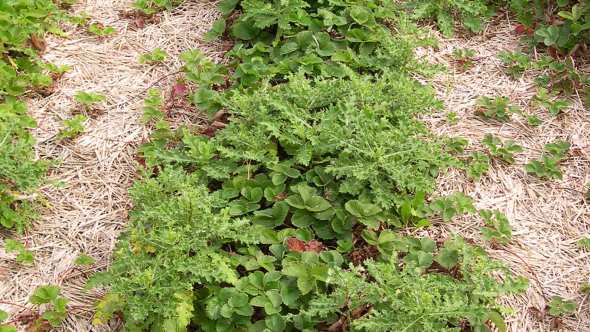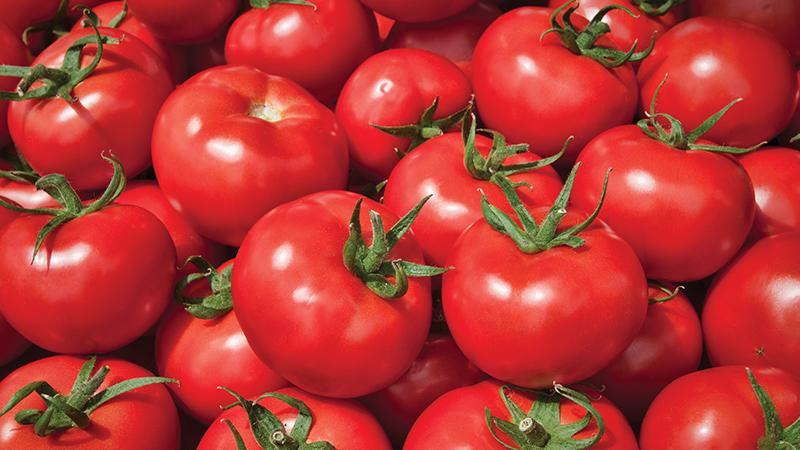Get A Grip On Weeds In Strawberries

Be mindful when tilling that Canada thistle has underground rhizomes that can resprout when chopped up.
Photo credit: Kathy Demchack
It’s not uncommon for weeds to pop up early in the spring and catch you off guard. And spring is just around the corner.
Weeds that germinate in the fall and survive through the harsh winter months often will appear in surprising numbers, presenting a formidable challenge.
With a little knowledge and pre-paration, however, strawberry growers can prevent weed germination in the fall through a mixture of techniques and avoid the unwelcome surprise come spring.
According to Kathleen Demchak, Senior Extension Associate at Penn State University, production systems, such as matted-row versus plasticulture, will affect the extent of germination and growth of winter annuals.
“If you’re in matted-row production systems where you’re normally applying straw in the late fall and early winter to your strawberry plants — and if that straw blows off, or if you have bare spots where it wasn’t applied very thickly — winter annuals can germinate and take off in the springtime,” Demchak says.
Plasticulture systems that use row covers also provide an ideal growth environment for weeds during the winter months, she explains.
Apply Herbicides
Regardless of what production sys-tem you employ, using pre-emergence herbicides on your fields before the weeds germinate will help.
Two recommended pro-ducts are Devrinol (United Phosphorus Inc.) and Sinbar (DuPont). Devrinol can be used in early fall, though Demchak advises waiting until strawberry plants have established enough runners and daughter plants.However, Devrinol breaks down in sunlight, so is ideally used just before mulching for the winter, she adds.
In addition to its use as a pre-emergent, Sinbar offers kickback activity to control weeds that have already emerged.
“If the weeds are already emerging, it will basically burn the young weeds, but just for a very short time. If the weeds are getting to the point where they are more than an inch tall, it will not likely get full control of them,” she explains.
Taking action ahead of time is crucial, because once spring arrives and weeds have emerged, there are very few control options left. Using a burndown herbicide is one technique, but Demchak cautions this method only burns the tops of the weeds, leaving the root system intact. Another option at this stage is hand pulling.
Weeds To Watch
In Pennsylvania where Demchak is based, common chickweed is by far the Number One weed problem. After that, it’s shepherd’s purse.
“With shepherd’s purse, it’s not a terribly competitive weed in terms of size, but it can produce a crazy number of seeds, so you can end up with a lot of plants for that reason,” she explains.
Common chickweed is able to toler-ate shade better than most plants, and it also roots at its nodes, creating a large “mat” with the ability to pro-duce more than 10,000 seeds. It germinates in the fall and flowers, and sets seed in the spring and early summer.
Similarly, shepherd’s purse ger-minates in late summer/early fall, and produces seeds in the late spring and early summer. The seeds from shepherd’s purse are held in heart-shaped pockets on the plant, and are in the tens of thousands, Demchak says.
Dandelion and Canada thistle also are troublesome. Canada thistle has underground rhizomes that can resprout when chopped up, so it’s important to be aware of this when tilling, otherwise you may end up with a colony in the middle of your field, she warns.
“One of the things we recommend for Canada thistle in the spring is using burndown material. Because its root reserves are fairly low at that point, it will help. Growers also can use Stinger (Dow AgroSciences), but they should be aware that it does have a 30-day preharvest interval. Be sure to check the label; it can only be used in certain states,” she says.
Cultural Controls
Herbicides aren’t the only option for weed control. Crop rotation and cover crops are also strong management tools that can reduce the number of springtime weeds, Demchak says.
“We definitely recommend using rotations that give you options for controlling weeds before the strawberry plants go in. For example, grow annual crops where you can use tillage to a greater extent than in strawberries to deplete the weed seedbank,” she says.
By rotating crops, growers are able to apply herbicides that can’t be used on strawberries, providing additional control by the time strawberry planting rolls around. For rotations, Demchak recommends growing crops in the grass family such as corn, oats, rye, or wheat.
“Rye has some allelopathic effects in terms of inhibiting weed seed germination, so that’s another crop we’ll often recommend growers rotate with,” she says.
In addition to helping with weeds, grass crops don’t harbor the same diseases commonly found in strawberries, so they have the added benefit of avoiding disease buildup.









